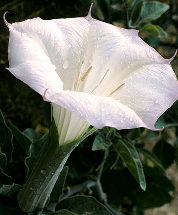
Explain the structure of the Datura plant with diagram.
Answer
558.6k+ views
Hint: The Datura is a genus including nine species of poisonous flowering plants that are usually active and bloom during the evening that belongs to the family Solanaceae. They are commonly called Thornapples, Jimson Weeds or Devil’s trumpets. It is also called moonflower, Devil’s weed, Hell’s bells, etc.
Complete answer: The Datura species are known to be grown in dry, temperate and subtropical regions of America and are mostly distributed in its centre of origin, Mexico. Datura plant is characterized by a height of about 2 metres. It is a herbaceous, leafy annual and short-lived perennial plant. It has alternate leaves which are 10-20 cm long and 5-18 cm broad.

Its flowers are characterized by:
1. It has a swollen green slender stalk present at the base of the flower on which the whorls of the flower are arranged (it is called thalamus).
It has a green tube-like structure at base, and the top of this tube has five segments which are arranged
in such a manner that it forms a tube. This whorl of five segments is called the calyx. Each of the parts of the calyx is called a sepal. Datura has united sepals. This protects the other inner parts of bud from environmental damage.
2. The most radiant and showy part of the flower is called the corolla. It is made up of petals. It has united petals which are longer than they are wide. It attracts the insects for pollination.
3. The male reproductive part or stamen consists of an anther and a filament. Anther produces pollen.
4. There are five stamens which form a whorl called androecium. The central part of the flower is called a carpel. The swollen part at the base of the flower is called the gynoecium.
5. It consists of the ovary which contains ovules; ovules develop into seeds after fertilizer. A long slender part is called the style, and at the top, a velvety soft part called the stigma is present.
Note: All species of Datura are poisonous and have the potential to cause psychoactive results. Its seeds and flowers are especially known to cause respiratory depression, arrhythmias, fever, delirium (decline in mental functioning), hallucinations and psychosis (an abnormal condition of the mind that results in difficulties determining what is real and what is not); also it can cause death if taken internally. It is used as a hallucinating agent due to its effects and the symptoms.
Complete answer: The Datura species are known to be grown in dry, temperate and subtropical regions of America and are mostly distributed in its centre of origin, Mexico. Datura plant is characterized by a height of about 2 metres. It is a herbaceous, leafy annual and short-lived perennial plant. It has alternate leaves which are 10-20 cm long and 5-18 cm broad.

Its flowers are characterized by:
1. It has a swollen green slender stalk present at the base of the flower on which the whorls of the flower are arranged (it is called thalamus).
It has a green tube-like structure at base, and the top of this tube has five segments which are arranged
in such a manner that it forms a tube. This whorl of five segments is called the calyx. Each of the parts of the calyx is called a sepal. Datura has united sepals. This protects the other inner parts of bud from environmental damage.
2. The most radiant and showy part of the flower is called the corolla. It is made up of petals. It has united petals which are longer than they are wide. It attracts the insects for pollination.
3. The male reproductive part or stamen consists of an anther and a filament. Anther produces pollen.
4. There are five stamens which form a whorl called androecium. The central part of the flower is called a carpel. The swollen part at the base of the flower is called the gynoecium.
5. It consists of the ovary which contains ovules; ovules develop into seeds after fertilizer. A long slender part is called the style, and at the top, a velvety soft part called the stigma is present.
Note: All species of Datura are poisonous and have the potential to cause psychoactive results. Its seeds and flowers are especially known to cause respiratory depression, arrhythmias, fever, delirium (decline in mental functioning), hallucinations and psychosis (an abnormal condition of the mind that results in difficulties determining what is real and what is not); also it can cause death if taken internally. It is used as a hallucinating agent due to its effects and the symptoms.
Recently Updated Pages
Why are manures considered better than fertilizers class 11 biology CBSE

Find the coordinates of the midpoint of the line segment class 11 maths CBSE

Distinguish between static friction limiting friction class 11 physics CBSE

The Chairman of the constituent Assembly was A Jawaharlal class 11 social science CBSE

The first National Commission on Labour NCL submitted class 11 social science CBSE

Number of all subshell of n + l 7 is A 4 B 5 C 6 D class 11 chemistry CBSE

Trending doubts
What is meant by exothermic and endothermic reactions class 11 chemistry CBSE

10 examples of friction in our daily life

One Metric ton is equal to kg A 10000 B 1000 C 100 class 11 physics CBSE

1 Quintal is equal to a 110 kg b 10 kg c 100kg d 1000 class 11 physics CBSE

Difference Between Prokaryotic Cells and Eukaryotic Cells

What are Quantum numbers Explain the quantum number class 11 chemistry CBSE




